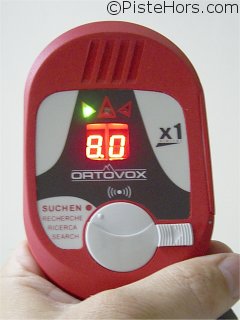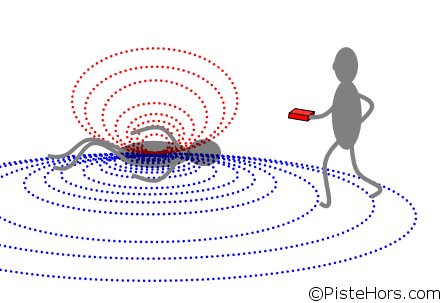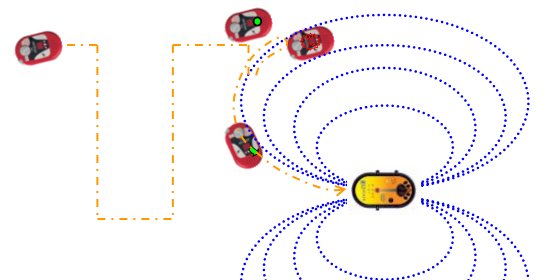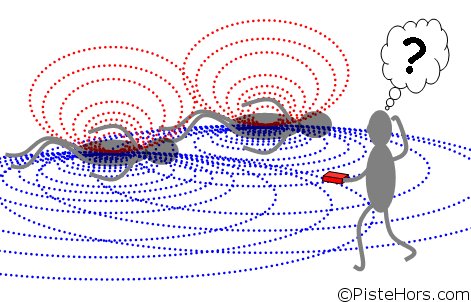
Gear > Avalanche Gear > Avalanche Transceivers > Digital Beacons > Ortovox X1
Ortovox's analogue avalanche transceivers became the de-facto standard during the 1990s. So much so that the German firm was seemingly caught napping with the shift to digital technology came towards the end of the decade. First the American Tracker DTS, then the French Arva 9000 and Swiss Barryvox Opto 3000 showed that improvements could be made in the man-machine interface and so aid searchers, particularly novices.
Ortovox? responded in 2001 with the X1. Housed in their standard compact and ergonomic lozenge case the X1 was supposed to marry the best parts of digital and analogue worlds in a simple to use and minimalist beacon. However before going further it is perhaps helpful to discuss what we mean by digital and analogue.

At their basic level all transceivers work in the same way. Transmitting pulses on an internationally agreed frequency of 457KHz. The rate and duration of these pulses varies between transceiver models but must fall within certain limits described by European standard EN 300 718. This standard also specifies the frequency tolerance as well as shock and waterproofing of avalanche beacons. What it does not do is define any procedure for comparing search times between devices or for how transceivers should operate in the case of multiple burials. The receiving circuitry has a certain tolerance around the 457KHz point (the bandwidth) but range decreases towards these limits. The transmitting circuitry, even when regulated by a quartz crystal, can drift which is why beacons should be serviced every few years. Ortovox themselves have criticised the EN 300 718 standard saying, amongst other things, that it is not precise enough to ensure interoperability without extensive testing beyond the capacity of manufacturers.
An analogue device passes the signal it receives through to a loudspeaker leaving the searcher to interpret what it all means. By using a volume control the searcher can home in on the buried beacon. The Ortovox F1 adds Light Emitting Diodes (LEDs) to indicate signal strength, these can help when making a flux-line search which are usually faster than grid or cross searches although some people find visual aids distracting, preferring to use their ears and concentrating on the search zone with their eyes.
Digital transceivers interpose a microprocessor between the received signal and the searcher. Signal strength is interpreted by a digital signal processor to give the user an indication of distance and when the user is aligned with the flux line. The Tracker DTS and Barryvox Opto 3000 add a second antenna and the information from this is used to indicate whether the user should turn left or right to stay on the flux line. Digital beacons require a certain signal strength to operate which reduces their range. They also employ different strategies for coping with multiple burials. In principle they lock on and display readings from the strongest signal but may also indicate if there are multiple victims and allow beacons that have already been located to be excluded in some way. Remember that in a real situation it may take some time to dig out and switch off a buried transceiver.
Digital devices have been sold on the basis of their ease of use. The computer brain simply guides the user through the various stages of the search until the buried beacon is found. Although you can just put a digital device in the hands of novice and tell them to go seek to be effective in a real life situation, particularly where there are multipleburials, training and regular practice are essential.
Like the Tracker DTS and Barryvox Opto 3000 the Ortovox X1 has two antenna^1^. These are aligned in an 'L' configuration within the case. The second antenna is only used in directional search mode, the device transmits on a single antenna. Using two antenna has the advantage that the transceiver can easily detect any divergence from the flux line by comparing the two signals. As the beacon diverges from this line one antenna is increasingly in alignment, giving a stronger signal in that antenna.

Beacon antenna misaligned
The X1 has a hybrid analogue/digital interface. This is should give the user the advantage of the greater range of an analogue beacon coupled with the precision of a digital. When searching a large avalanche having a bigger search strip could save time. Tests between analogue and digital beacons show that range has little affect on overall search times as the digital beacon is quicker over the secondary search phase. However a hybrid beacon such as the X1 would appear to offer the best of both worlds.
Our first test was a range check. Placing a transmitting beacon on the ground our group started towards the beacon armed with the X1, an Ortovox F1 and an Arva 9000. The F1 picked up the first signal, at around 50 meters out, next was the X1 at around 45 meters then finally the Arva 9000 at 35 meters. The X1 does offer a somewhat greater range than a digital beacon but surprisingly was not quite as good as its sibling F1 and the range was not as far as quoted in the marketing blurb2. It is hard to imagine a better situation than a transceiver sitting at ground level with antenna aligned, maybe we just didn't have sensitive enough ears?
We now buried a single beacon at 50cm. The X1 starts out in analogue mode, static can be heard through the loudspeaker but there is no readout on the display. At the beacon starts to come in range the faint peep-peep of the victim's beacon is picked up. The green centre light will start to flash in time as the signal increases. At around 35 meters the distance indicator begins to display figures. Initially it is quite erratic, flipping on and off and with the distance changing by quite a number of meters without moving. This could be disconcerting for an inexperienced user, especially in the stressful situation of a real search. At this point all that can be done is to keep going in the same direction until the signal strengthens. The centre green light will clearly flash on and off at this point. At around 10 meters the Ortovox X1 switches into directional mode, the second antenna becomes active and the left and right LEDs indicate the direction to turn and the distance indicator counts down in 0.1 units (approximately equal to 10cm distance). Audible tones are now generated purely by the digital signal processor. We found that the direction lights were very sensitive, it took little movement to flip directly between left and right. This was initially confusing but we realised that splitting the difference between the two would keep the searcher on the flux line. As you approach the victim the flux lines get closer and closer and the vertical plane signals gain in strength. If you remember your transceiver practise the transmission from a beacon is strongest in one plane but the transmission footprint is 3 dimensional, if this were not so a victim buried upright would be undetectable. However this mass of information is confusing for the beacon's digital signal processor and distance direction information can jump all over the place3.

The Vertical Plane
The solution in the case of the Ortovox X1 is to switch off directional information within two meters of the victim. This is indicated by the centre LED being lit continuously and the two arrows turned off. Within the final search phase the distance indicator is used to localise the victim, the searcher passes the beacon slowly over the surface of the snow to find the lowest distance readings. Depending on the depth of burial and orientation of the victim's beacon you may see two or more minima. It is then a question of probing from the centre point in a spiral motion to locate the victim.

Search phases of the Ortovox X1
Ortovox claim that the X1 is the simplest beacon to use in practice. There are no user controls just a large, spring loaded switch in the centre of the beacon to move from transmit to receive. This has a lock on it which prevents unintentional switching of the unit when it is being worn. The switch is relatively easy to use with gloves on and can be quickly sprung back to transmit mode in the event of a secondary avalanche.
The unit is turned on by inserting a button on the end of a strap into a hole in the edge of the device. This strap loops over the shoulder and an elastic belt keeps the device snug and protected on the side of wearer. In theory this should prevent a user turning the unit off while still wearing the beacon. A green LED flashes to show that the device is transmitting. When the unit is switched on it performs a power on self test and indicates the battery condition as a percentage from 1-99%. At 10% charge there is approximately 20 hours usage in transmit mode and an hour in search mode. The transceiver takes two AA batteries. Alkaline type, non-rechargeable batteries should be used.
As noted we found the erratic distance indication disconcerting at first. When the user closes in on the victim the direction indicators can also lead you in first left then right as the beacon seemingly gets confused with the mass of flux line data. However with a bit of practise the beacon can quickly zoom in on a victim. The final search phase was easy and precise.
During our tests multiple victim searches were the one area where we this unit really fell down. If you read reviews of the Ortovox X1 elsewhere you'll come across claims such as these
Maybe there is some turbo version of the X1 they only give to people who write this puffery on e-Commerce sites. We feel these kind of statements, where lives may be at stake, to be irresponsible. In the X1 manual it simply mentions walking at right angles to the approach line used to locate the first victim (remember with maybe 15-20 minutes to dig out the first victim simply switching this beacon off is not an option).
So how do multiple victim searchers work in practise? If you are in range of the two beacons during the analogue search the beacons are clearly audible. If you didn't witness the avalanche this is a clear indication that you are looking for more than one beacon. During this phase, if the victims are reasonably widely spaced it should possible to orientate the X1 to approach one beacon or the other. Once the beacon switches to digital mode you only pick up one signal, when the first victim is located you can continue searching down the avalanche debris in a zig-zag pattern until you pick up the second transceiver, and if this doesn't work you can return to the first victim and search horizontally. Okay in a flat car-park but all of this takes time wading through avalanche debris on a 30 degree slope. There is no way to screen out the first beacon except by rotating the X1 to misalign the antenna and of course this may be misaligning the antenna of the second beacon.
In practise we found things much more confusing. Considering that the Ortovox is sold as being easy to use we expected more. Our first problem was that once the unit we were testing was in digital mode it wouldn't necessarily stay locked on to the first beacon but would flip-flop between the two victims. This depended on the proximity of the victims but we had cases of standing directly over one victim then unit would flip over to a beacon buried some 4 meters away. At first we thought this was some useful feature but there was no mention of it in the manual. It would be great if the beacon would hunt around and you had some way of locking on to each signal but this is not the case. What seems to happen is that the X1 has trouble locking onto a single signal. This is very confusing as the flip-flops last some 5 seconds. Searching around on Internet forums showed people with similar experiences.

Multiple Avalanche Victims in proximity, never easy to find
When the two victims were in close proximity the X1 seemed to have a predilection for one beacon. Unless one walked directly over the second beacon by chance we seemingly got lead around in circles to the first beacon or got confused by the flip-flopping we've already described. One strategy we used was returning to the point where we first heard two signals in analogue mode and then trying to follow the second signal, however if the search path led close enough to the first transceiver we would often get sucked into its gravitational field, the X1 switching to digital and losing our second beacon.
Far from being the easiest beacon to use we found that the Ortovox X1 required a substantial familiarisation phase. After 6 hours of exercises we were still not confident about multiple victim scenarios. Even with a single victim the automatic switching from analogue, to digital, to directional to non-directional modes takes some getting used to. The erratic display at distance and the sensitivity of the direction indicators when closing in on the victim could perturb an inexperienced user. In the end we felt it may simply be better if the Ortovox switched to directional mode as far out as possible and give an option button to put the device into analogue mode for multiple victim searches. But then we could just buy a Tracker DTS or a Barryvox Opto 3000.
The problems we had with locating multiple victims are perhaps down to not enough practise with this transceiver. Again we come back to the marketing as an easy to use beacon which is clearly not the case. It may have reduced the user controls which would seem a sensible choice in the stressful situation of an avalanche search but at the expense of a more complicated interpretation of what is being displayed. If the switch between modes and display can't be made smoother then automation would seem to bring more problems than it solves.
We had major difficulties locating a Nic-Impex Arva 9000 beacon. The Ortovox X1 gave no direction indication whatsoever for this beacon and we had to make a cross search using the distance reading, we were firmly back in the world of beacons, circa 1980! We had no problems locating this beacon with an Ortovox F1. The problem could be due to a fault with the Arva 9000, perhaps the signal being slightly out of specification?^4^ However it would seem that the X1 is fairly intolerant. As we live in the real world where problems can occur with any beacon it would be advisable to conduct range and direction tests with your partners at the trail head.
Ortovox say that the LED display is better than the LCD units used in some beacons as it is much less sensitive to temperatures. We found that the range display was impossible to read in bright sunlight and the direction arrows hard to see. Not great on a clear, crisp winter's day. What with the erratic readout we were spending all our time concentrating on the beacon and not looking around the avalanche site for other clues. The device wasn't overly sensitive to mobile phones and other electromagnetic interference.
The manual sold with the device is fairly cursory and the English translation is imperfect. We got the feeling that Ortovox really expects the unit to be used in single victim searches. It would certainly encourage me to practise safe travel procedure.
Finally, although the 2004 X1 is sold as having updated software and a faster processor it still seems slow with a noticeable lag when you get close to the victim. This is a problem shared with other digital beacons but a searcher need to keep a cool head.
Date Tested: 16th August 2004
1 The X1, like the Ortovox d3, now has a third antenna.
2 Gary Brill posted similar findings on TelemarkTips avalanche awareness forum.
3 See the article Vertical Plane Searching by Dave Barber
4 Since writing this article we have had the ARVA 9000 beacon tested by the manufacturer who found that it was on specification.
If you've tried the Ortovox X1 write up your experiences here.
<< Tracker II? | Digital Beacons | Ortovox S1 >>